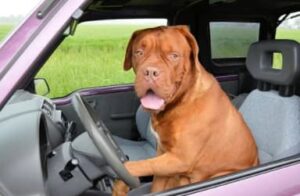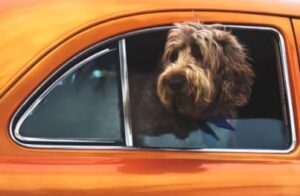When you first start up you might want, or need, to use your current vehicle for dog walking and most of the time this will be a car. Plenty of successful, happy dog walkers and their dogs are working daily from their cars.
So let’s delve into a common startup question. Do I need a van to be a dog walker?
Table of Contents
Pros and cons
As you’d expect the pros of choosing one become the cons of using the other.
Cars
Pros
- Better visibility driving and parking
- Dogs are already used to being in a car
- Access to the vehicle from all sides
- Still has 5 seats if it’s your only vehicle
- Easier to park closer to clients houses
Cons
- Harder to clean and keep dry
- Gets warmer in the summer due to the glass
- Harder to divide dogs and keep them apart
- People can see in whilst you’re collecting the next dog
- Dogs fall into the footwells if not secured correctly
- Damage to the car from dogs scratching/chewing
Vans
Pros
- Cooler in summer
- Easier to divide dogs
- Privacy when collecting other dogs
- Easier to clean
- Easier to sign write
Cons
- 3 Seats max unless you get a crew cab
- Dark and noisy in the back upsets some dogs
- Usually only one side door
- Larger vans are harder to find parking spots outside houses

Solutions to the cons
Cars;
Harder to clean and keep dry
Cover as many of the seats as possible with waterproof covers.
Run the aircon all year round to remove moisture from the air
Fold the back seats down and use crates if possible
Tuck unused seatbelts away or wrap them in towels and tape them up to stop chewing
Gets warmer in the summer due to the glass
Make/buy window shades
Make sure the aircon works
Can your car run aircon whilst locked? (as you nip in to pick up or drop off dogs)
Buy additional 12v fans
Harder to divide dogs and keep them apart
Buy tailor made boot dividers for your make and model
Ensure dogs are properly introduced and know each other before sitting together
Use dog guards between boot and back seats as usual but also between the back and front seats (use cable ties and the headrests)
People can see in whilst you’re collecting the next dog
Again, window shades.
Collect faster, park closer.
Dogs fall into the footwells if not secured correctly
Buy hammocks or footwell fillers.
Damage to the car from dogs scratching/chewing
Tuck as much out of the way as you can
Cover as much as you can

Vans
3 Seats max unless you get a crew cab
Most vans are built on the same chassis as the minibus/crew cab versions of the same van, so most will have the fixing points on the floor to add a double seat in the rear.
TOP TIP: If you look on some of the camper conversion Facebook groups specific to your van, people usually give these seats away for free just to get rid of them. Then just get a professional to fit them for you.
Dark and noisy in the back upsets some dogs
Insulating your van from road noise (and keeping it cooler in the summer) is actually an inexpensive addition to your van. Self-adhesive closed-cell foam is used in cars to reduce noise in the same way. Stick it over all exposed metal surfaces and ply line the van for extra noise reduction.
When it comes to the dark, consider removing the bulkhead in your van. These aren’t structural and can usually just be unbolted. This has the added benefit of you now being able to see the dogs whilst travelling. If this reduces privacy in the back, consider fitting a curtain to pull across when you’re collecting or dropping off dogs.
Usually only one side door
Not a lot you can do about this other than find a van with 2 loading doors.
Larger vans are harder to find parking spots outside houses
You will have to accept that you’ll probably be parking further away from clients’ houses, and in some instances, at the end of the road. Smaller vans won’t have this issue but as soon as you go up a size to a van where you step up into the driver’s seat, you’re going to have to consider this, even if you are the world’s best driver.

What do clients prefer?
I’m not sure clients think too much about it, but they probably should.
Many of us have struggled to get a dog back into the van or into a crate who is just refusing because he doesn’t like it, is scared of it and hasn’t been trained to use it. This dog will clearly be more suited to a walker who used a car.
Which is safer for dogs, Van or Car?
When loading and unloading dogs from your vehicle it’s much safer if they’re crated. Taking them calming out one by one, attaching leads to an anchor point on your van as you unload the next.
With a car, there are fewer anchor points, and perhaps 2 dogs who are keen to exit the vehicle at the same time from the back seat or boot. Having used cars and vans myself, it’s definitely a juggle getting excited dogs out of a car which is why I would have a crate on one side of the back seat.
This meant I could unclip the seatbelted dog first before walking to the other side of the car and getting the other from their crate.
When it comes to safety in a crash the only crates which are safer are those that state they’re crash tested. These tend to be metal, stand-alone crates rather than the stacked crate systems people have installed. Crash tested means they’re less likely to crush in an accident.
In comparison, the only harnesses recommended for car travel are specific car harnesses and not normal walking harnesses. That said, any harness clipped to a seatbelt is better than the dog being loose and never clipping them in by their collars.

When securing dogs in the boot of a car make sure the length of lead is appropriate for the dog. Long enough to allow them to settle down if they choose, but not so long that they can jump out of the boot as soon as it opens. The last thing you want is a dog jumping out with the lead essentially dangling him out of the boot.
Conclusion.
Car and vans both have their merits and their downsides. The downsides can be minimised and adjustments made to make them less of an impact on the dog’s enjoyment of travel.
Does using a car make you look unprofessional? I’d say no. Plenty of walkers use cars and manage to keep their dogs safe and run a successful business. If the walker who has the shiniest, fanciest, newest van pulls up and lets 8 unsecured dogs out from the back, that’s unprofessional. It’s not the vehicle, it’s the person who makes a business professional.
Ultimately, as your business grows and you learn what your personal ideal walk looks like, this will lead you one way or the other.
If you enjoy, and have dogs who enjoy, walking a large group in a secluded place and everyone has great parking and massive driveways, then a bigger van will be ideal.
But if you prefer smaller groups, closer to home, or even if you decide to target your business to fulfil the needs of dog’s who need solo walks, then a car may be better.
What do dogs prefer? – Having used cars and vans myself, I have a sneaking suspicion that dogs prefer to be able to see out when travelling.
